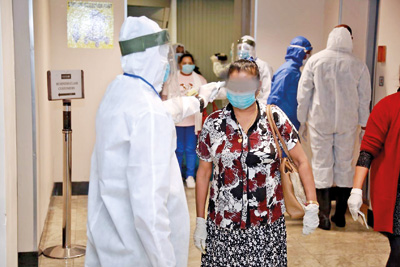News
Desperate migrants return to jobless country unable to help
Thousands of Sri Lankan migrant workers, mostly female breadwinners, who lost their jobs due to the coronavirus pandemic and returned home, are confronting the reality of being unemployed, where joblessness has increased.

Returning migrant workers undergoing fever checking at the BIA. Pic by T.K.G. Kapila
Some are surviving on their meagre savings and becoming street vendors.
According to the Foreign Employment Bureau, about 20,000 have lost jobs in West Asia.
Thousands more are expected to return.
Bureau deputy general manager, Mangala Randeniya, told the Sunday Times that migrant workers have been told not to rush to return if they have proper lodgings, health insurance and are able to find jobs once the pandemic comes under control.
“The government can’t pay a monthly sum of about Rs. 30,000 to Rs 50,000. Those who have arrived are suffering financially and psychologically. Our officers visit those who have come, to provide psycho-social counselling and career guidance,” he said.
Foreign Secretary Ravinath Aryasinha said this week, jobs overseas have disappeared.
There is more unemployment, loss of contracts, non-extension of work permits and halting of temporary freelance work, which have left many of the migrant workers largely destitute.
“It was noted that this could lead to a serious shortfall in the numbers of migrant workers who will leave for work this year and in turn a drop in worker remittances.”
In 2019, migrant worker remittances to foreign exchange earnings were 25.5%, while its contribution to Sri Lanka’s economy was about 8%, Mr. Aryasinha said.
Around 1.5 million Sri Lankan migrant workers are overseas and about 85 percent of them are in West Asia. About 97% are domestic helpers and 71.8% are unskilled workers. They are mostly working in Saudi Arabia, Qatar, Kuwait and the United Arab Emirates.
According to the World Health Organization, Saudi Arabia has recorded close to 200,000 virus patients with 1,752 deaths. Qatar has about 100,000 confirmed patients and 118 deaths. Kuwait has reported 47,000 with 359 deaths and the United Arab Emirates close to 50,000 and 317 deaths.
Mr Aryasinha said the crisis has also exposed the significant number of Sri Lankan migrant workers who are undocumented/irregular, and as a result are ineligible to get medical and other benefits and are also vulnerable to deportation.
A sociologist is calling for government help for these returnee migrant workers.
“Middle East migrant workers, especially those in unskilled category fall into vulnerable groups during this pandemic. They go abroad to get away from the poverty cycle, and return without a job, loans to be repaid, houses half built and immediate and extended families depending on them financially,” said Dr. Nishara Fernando, Head of the Department of Sociology, University of Colombo.
Dr. Fernando said most of them will use up their savings in the coming months, but the government must assist and encourage them into self-employment, create opportunities in the agriculture sector, or provide vocational training.
“As banks are reluctant to give loans to them, they fall prey to informal money lenders. This will lead to many social issues including some involving illegal activities. Similar to including economists, presidential task forces appointed should include qualified sociologists who have done research on this field and get their expertise to empower migrant workers,” he suggested.

